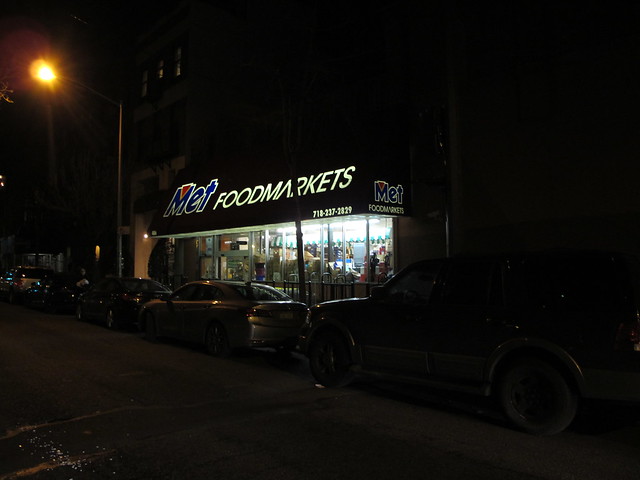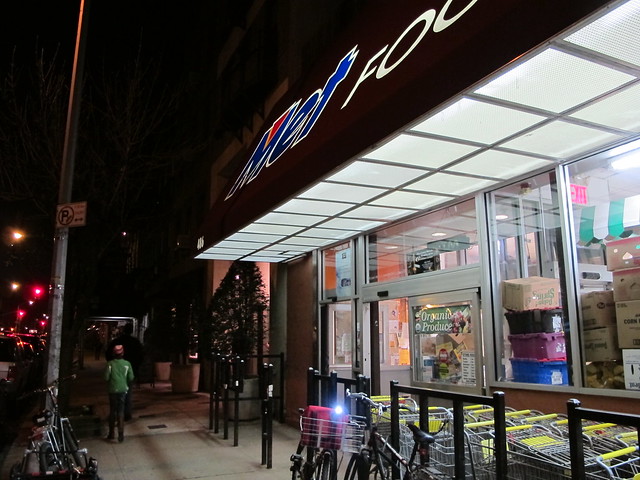This week, the Met Food supermarket at 486 Henry Street here in Carroll Gardens is transitioning into a Key Food. Though the awning in front of the store has not yet been changed, the store receipt already indicates that it is officially a Key Food.
It will probably not make much of a difference, except for the sales items and the store brands stocked on the shelves. I think most neighborhood residents will just be glad that this will remain a supermarket.
Carroll Gardeners have been complaining about a lack of reasonably priced food shopping options in the neighborhood. In the past few years, the neighborhood has lost two supermarkets.
First, the old Key Food supermarket on Court Street between First Place and Second Place closed and became a CVS. Then this past summer, the Met Food on Smith Street closed its doors to make way for a new building.
Below is a bit of history about the building housing the current supermarket at 486 Henry Street. It was once the home of the Pilgrim Chapel and later became the Oriole Theatre.



This is from the New York Chapter of the American Guild of Organists:
The Pilgrim Chapel began as the Columbia Mission, established in 1845 or 1846, when a few active Christians began a Mission in Freeman's Hall at the corner of Amity and Columbia streets in South Brooklyn. The neighborhood was inhabited mostly by foreigners, many of whom were Irish Catholics. As the Sunday-school was established and prospered, a few benevolent gentlemen purchased three lots of ground on Warren Street, between Hicks and Columbia streets. On this ground, a chapel was erected that could accommodate 400 to 500 persons, and it was completed in November 1852, free of debt. The cost of the land and chapel was about $9,000. Over the next few years membership increased and on March 20, 1854, a church was formed. Financial support for the Warren Street Church was provided by Plymouth Congregational Church and the Church of the Pilgrims, in addition to contributions from members. In 1876, the Church of the Pilgrims assumed charge of the mission, and it was renamed Pilgrim Chapel.
On July 10, 1878, the cornerstone was laid for a new building on Henry Street at the corner of Degraw Street. The site consisted of four lots and measured 100 feet square. J. Cleveland Cady (1837-1919), the prominent architect, designed an Italianate-style building with a tall tower that had an exterior of Philadelphia pressed brick trimmed with Belleville stone and terra cotta. The auditorium had a high ceiling with open timbers, and was lighted by a continuous clear-story in which were windows filled with rolled cathedral glass of beautiful designs. There were 15 rooms grouped around the auditorium, all having direct light, ventilation and heat. When the Sunday-school rooms were opened into the auditorium, there was a capacity of 1,200 people. The new Pilgrim Chapel was formally opened on December 15, 1878.
The Church of the Pilgrims merged into Plymouth Congregational Church in 1934, but it has not yet been determined when the Pilgrim Chapel was disbanded.
A while back, Reader Carol commented on PMFA that she had spoken to her mother who told her that when she got married in 1947, this supermarket "was known as the C-Town Market. Then it became G & G, which was owned by the Gallatto Brothers."
According to Carol, Mr Park's, who also owned the Met Food on Smith Street, opened this Met Food in the 1980's.
Read more
It will probably not make much of a difference, except for the sales items and the store brands stocked on the shelves. I think most neighborhood residents will just be glad that this will remain a supermarket.
Carroll Gardeners have been complaining about a lack of reasonably priced food shopping options in the neighborhood. In the past few years, the neighborhood has lost two supermarkets.
First, the old Key Food supermarket on Court Street between First Place and Second Place closed and became a CVS. Then this past summer, the Met Food on Smith Street closed its doors to make way for a new building.
Below is a bit of history about the building housing the current supermarket at 486 Henry Street. It was once the home of the Pilgrim Chapel and later became the Oriole Theatre.
Architectural drawings of Pilgrim Chapel
A photo of the 1930's
This is from the New York Chapter of the American Guild of Organists:
The Pilgrim Chapel began as the Columbia Mission, established in 1845 or 1846, when a few active Christians began a Mission in Freeman's Hall at the corner of Amity and Columbia streets in South Brooklyn. The neighborhood was inhabited mostly by foreigners, many of whom were Irish Catholics. As the Sunday-school was established and prospered, a few benevolent gentlemen purchased three lots of ground on Warren Street, between Hicks and Columbia streets. On this ground, a chapel was erected that could accommodate 400 to 500 persons, and it was completed in November 1852, free of debt. The cost of the land and chapel was about $9,000. Over the next few years membership increased and on March 20, 1854, a church was formed. Financial support for the Warren Street Church was provided by Plymouth Congregational Church and the Church of the Pilgrims, in addition to contributions from members. In 1876, the Church of the Pilgrims assumed charge of the mission, and it was renamed Pilgrim Chapel.
On July 10, 1878, the cornerstone was laid for a new building on Henry Street at the corner of Degraw Street. The site consisted of four lots and measured 100 feet square. J. Cleveland Cady (1837-1919), the prominent architect, designed an Italianate-style building with a tall tower that had an exterior of Philadelphia pressed brick trimmed with Belleville stone and terra cotta. The auditorium had a high ceiling with open timbers, and was lighted by a continuous clear-story in which were windows filled with rolled cathedral glass of beautiful designs. There were 15 rooms grouped around the auditorium, all having direct light, ventilation and heat. When the Sunday-school rooms were opened into the auditorium, there was a capacity of 1,200 people. The new Pilgrim Chapel was formally opened on December 15, 1878.
The Church of the Pilgrims merged into Plymouth Congregational Church in 1934, but it has not yet been determined when the Pilgrim Chapel was disbanded.
A while back, Reader Carol commented on PMFA that she had spoken to her mother who told her that when she got married in 1947, this supermarket "was known as the C-Town Market. Then it became G & G, which was owned by the Gallatto Brothers."
According to Carol, Mr Park's, who also owned the Met Food on Smith Street, opened this Met Food in the 1980's.
Read more












.JPG)
